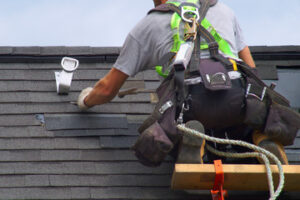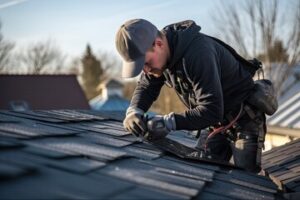Corpus Christi Roofing CO is an exciting and challenging form of construction that provides shelter from rain, snow, sunlight, extremes of temperature and wind. There are 64 practical types of roofs, ranging from sloped ones like the gable or hipped roof to flat roofs.
A roof’s top layer is a layer of shingles. These come in a variety of colors and materials.

Roofing is the process of covering a building’s top to protect it from rain, snow, sunlight, and extreme temperatures. Various materials are used to create roofs, which can be flat or have a sloped surface. Roofing materials are chosen for their durability, cost, and appearance.
Wood roofing lends a classic, natural look to homes. Cedar and redwood are popular choices, but other varieties exist. While attractive, this type of roofing doesn’t hold up well in damp climates. Also, it’s a fire risk and needs to be treated with chemical preservatives and flame retardants. Wood shingles are sawmilled for uniformity, while shakes are split into wedge-shaped pieces and offer a more rugged look.
Another type of roofing is metal. This durable material is available in a wide range of styles, colors, and finishes to match any home. The most common types of metal roofs are EPDM membrane, which is glued to cover boards or insulation and lasts 10-15 years; and TPO, which is mechanically fastened with hot air to the cover board or insulation.
Other durable roofing options include tile and slate. Tile is a popular choice in the Southwest, but can be found across the country in Mission and Spanish-style homes. Slate is a more costly option but offers the beauty of natural stone. Flashing, which is sheet metal placed where the joints of a roof change direction, helps seal water from entering the building. Other protective materials include underlayment, a water-resistant paper layer, and a vapor barrier, which restricts the passage of moisture through the roof system and walls.
Design
Roofs play a vital role in protecting buildings and their inhabitants from rain, snow, sunlight, wind, and extreme temperatures. They are available in a variety of shapes and sizes to meet different functional and aesthetic requirements. The design of a roof is determined by its structure and material, as well as the construction method. A pitched roof has a sloping surface, which allows water and snow to flow off the building and prevent leaks. It also provides additional attic space and headroom. Another popular roof style is a gable roof, which has angled sides and is ideal for areas with heavy rainfall or snowfall. It also allows natural light to penetrate the home and minimizes electricity usage. Another option is a truss system, which is triangular and can withstand tensile or compressive stress.
Installation
No part of your house takes more of a beating than the roof. It has to endure high winds, pounding rains, hail, bitter cold, intense heat, and relentless sun exposure. But a well-installed roof can take it all in stride and keep your home safe, comfortable, and beautiful year after year.
When you’re ready to reroof, look for a contractor with local references and credentials. Ask about state and local licensing, bonding, a good Better Business Bureau rating, and active certificates of insurance—both liability and workers’ compensation. Look for a manufacturer’s credentialed contractors, which might mean they have more training in installing that particular roofing type.
A contractor will begin by laying underlayment over the entire roof surface, then sheathing it with shingle tabs and nails, close together along the edge of the first row, and spaced farther apart near the middle. The next row will be nailed to the underlayment in a similar pattern, with nails closer at the edges and spread out farther towards the center. The contractor will continue this process until she reaches the roof’s ridge, at which point she will waterproof the valleys (the areas where sloped sections of the roof meet). This is typically done by running underlayment and felt paper over the shingles and nailing it down firmly.
Maintenance
Your roof is one of the most complicated and delicate parts of your home. It takes a beating from wind, rain, snow and the sun’s scorching rays. It’s also harder to keep tabs on than a facade or windows, which are visible at all times of day. That’s why it pays to have a regular maintenance program to keep up with the issues that can arise from weather and normal wear and tear.
This can include cleaning the gutters regularly, especially after heavy storms and as each new season approaches. Checking for damaged or missing shingles is also important and should be done at least once a year. During this inspection, it’s also good to look at the caulking around chimneys and vent pipes. If it’s starting to lift up in areas or look brittle, it may be time for a replacement. If you are in the market for new caulking, we recommend using a product like Wakaflex that’s flexible and non-toxic.
It’s also a good idea to check the flashing (a strip of metal that waterproofs the area where two roof sections meet) and the soffit and fascia for dents, gaps and signs of rot. You can also inspect the chimney for loose bricks and cracking mortar, as well as checking the roof penetrations such as skylights and vents. If you notice any of these issues, it’s a good idea to get them repaired as soon as possible.
Having regular maintenance is the best way to ensure that your roofing lasts for as long as possible, without incurring major repairs or even total replacement. Contact us for more information on our maintenance program, and how it can help your property. We can also provide you with a roster of our crew members that you can run background checks on, and that you will be familiar with. We are fully licensed and insured, and have been performing roofing and maintenance work for over 20 years.
Sales
Roof repair and replacement is a steep investment for homeowners. Many have to pay out-of-pocket and file a claim for insurance coverage on the work. To soften the blow for your customers, consider offering financing options and pre-qualification. Many people put off much-needed repairs because they can’t afford the upfront costs. Offering payment terms and even zero-percent financing can help them get the job done and avoid costly damage to their home.
To be successful in roofing sales, you must understand your customer’s needs and wants. You must be able to explain the benefits of a new roof, and how it will protect their home for years to come. It’s also important to have a well-crafted sales pitch that conveys your expertise, and highlights your company’s values.
If you’re looking to hire a salesperson, it’s essential to set clear expectations about their salary and commission structure. This information will allow you to filter out candidates who are not a good fit for your business. It’s also useful to provide a range for the salary, so that you can recruit applicants with varying levels of experience.
Retail sales roofers are larger companies that may do both storm chasing and regular roof replacements. They may offer a wider range of materials, and their sales presentations are typically longer and more detailed. They usually start with the highest priced option and are often willing to negotiate for prices that work within the homeowner’s budget.
The final thing to keep in mind is that roofing is a high-pressure sales environment. Some people don’t thrive in it, and end up quitting too soon. This is a real problem for the industry because it prevents newcomers from gaining valuable experience.
To avoid this, it’s crucial to set clear sales goals and support your employees in achieving them. For example, a gross margin percentage can be a great incentive for your roofers, as it reflects the amount of revenue they generate minus the cost of goods and services.

